Albert Bierstadt's Biography
Discover Albert Bierstadt: Hudson River School luminary and painter of the American wilderness.Albert Bierstadt’s Chronology
Over The Years
1830
- January 7, 1830: Albert Bierstadt was born in Solingen, Prussia, as the sixth child and fourth son of Heinrick Bierstadt (July 16, 1785 – July 1, 1866) and Christiana M. Tillmans Bierstadt (August 14, 1791 – October 21, 1864).
Older siblings
- Charles: November 28, 1819 – June 5, 1903
- Helen: December 7, 1822 – March 6, 1905
- Edward: September 19, 1824 – June 15, 1906
- Anne Wilhelmine: August 10, 1826 – July 11, 1832
- John Wilhelm: September 14, 1828 – March 1829
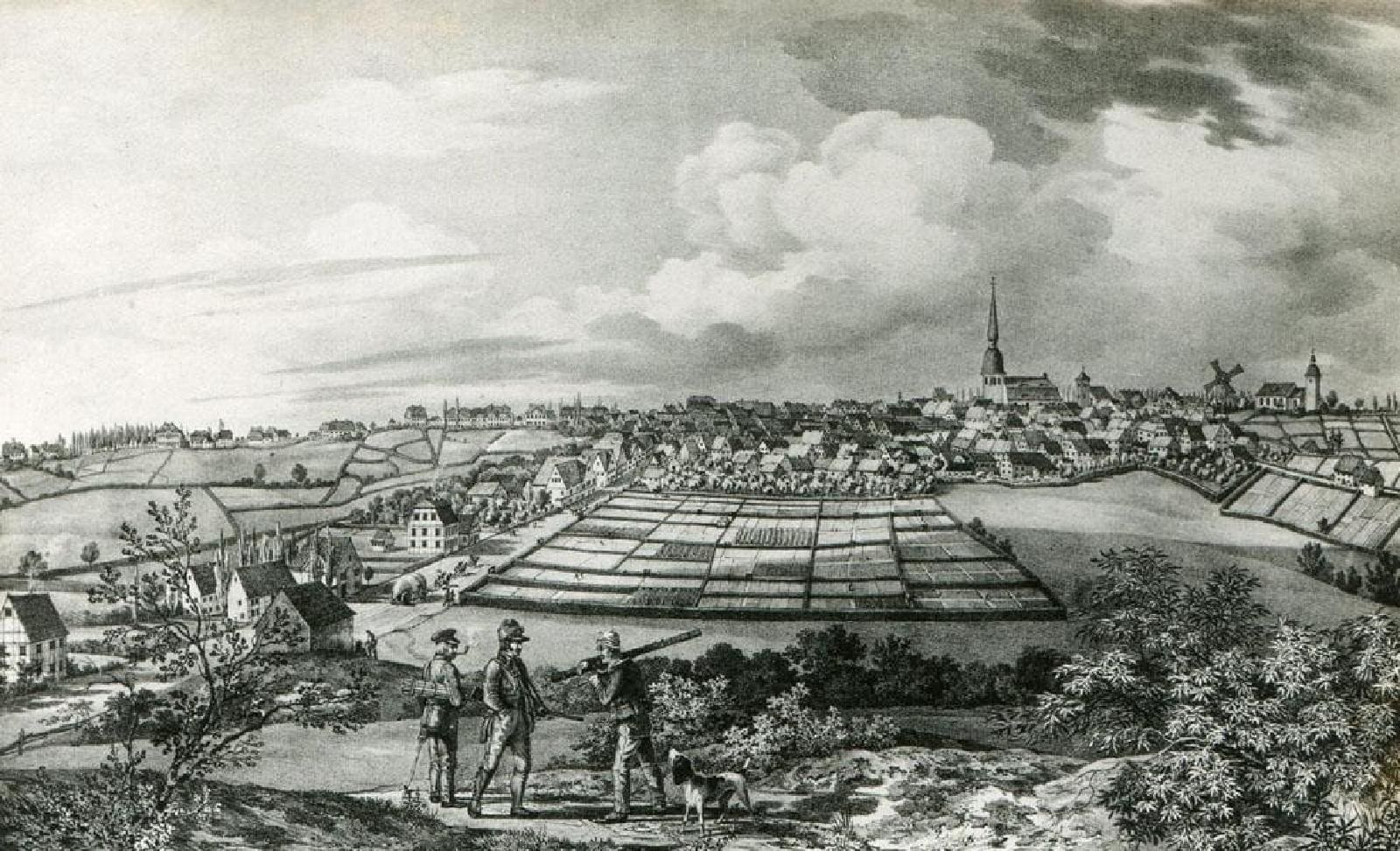
An 1829 lithograph of Solingen, Germany, the birthplace of Albert Bierstadt.

Portraits of Heinrick Bierstadt and Christiana M. Tillmans Bierstadt, Albert's parents.
1832
- August 2, 1832: The Bierstadt family arrives in New Bedford, Massachusetts, on the brig ‘Hope‘ from Rotterdam, Netherlands. Henry Bierstadt is recorded as a 45 year old cooper on the ship’s passenger list. Tragically, Anne, the family’s youngest daughter passed away during the ship’s voyage. Albert was only 1 year and 6 months old.
1833
- August 3, 1833: A year later, Elizabeth (Eliza) Bierstadt was born in New Bedford, Massachusetts.
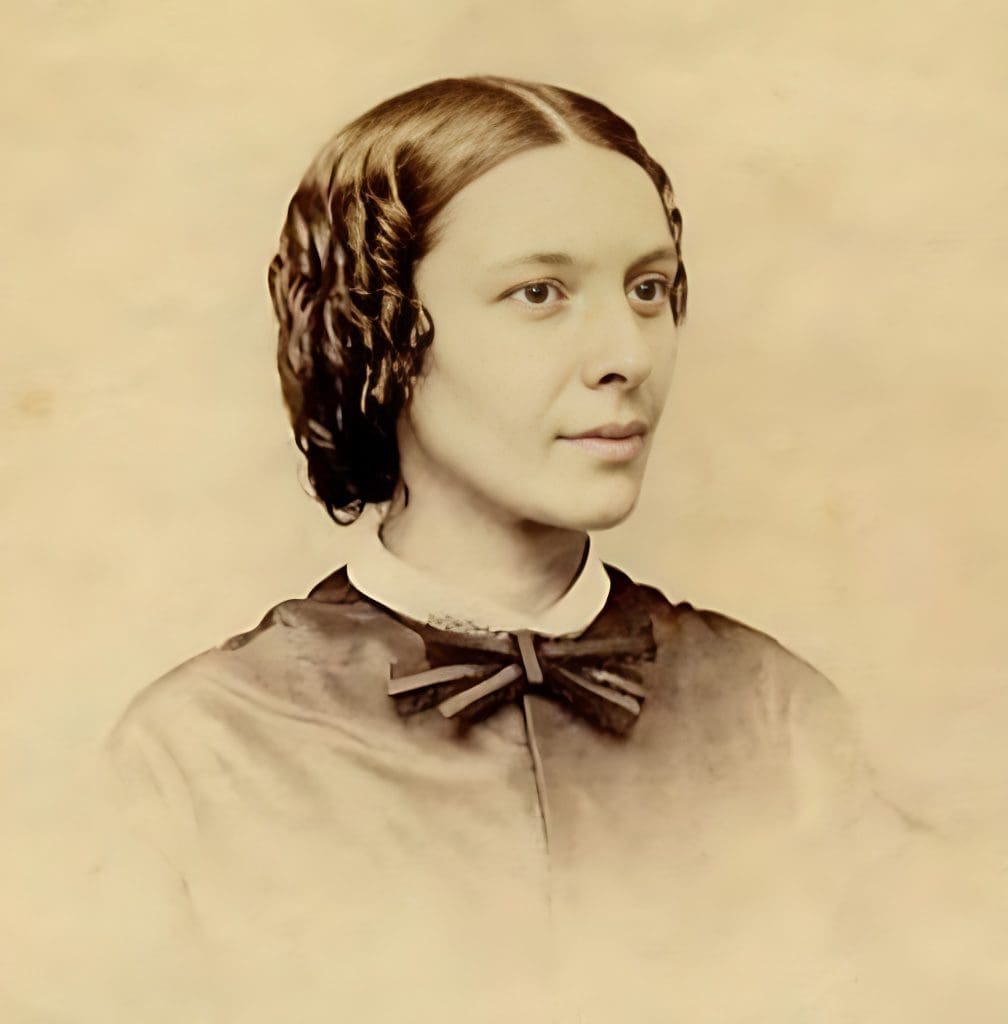
Portrait of Eliza Bierstadt, Albert's younger sister.
1836
- Henry Bierstadt (spelled as Bierstead) is listed in the New Bedford City Directory, 1836, occupation cooper, residing at 11 Mill, corner Ray.
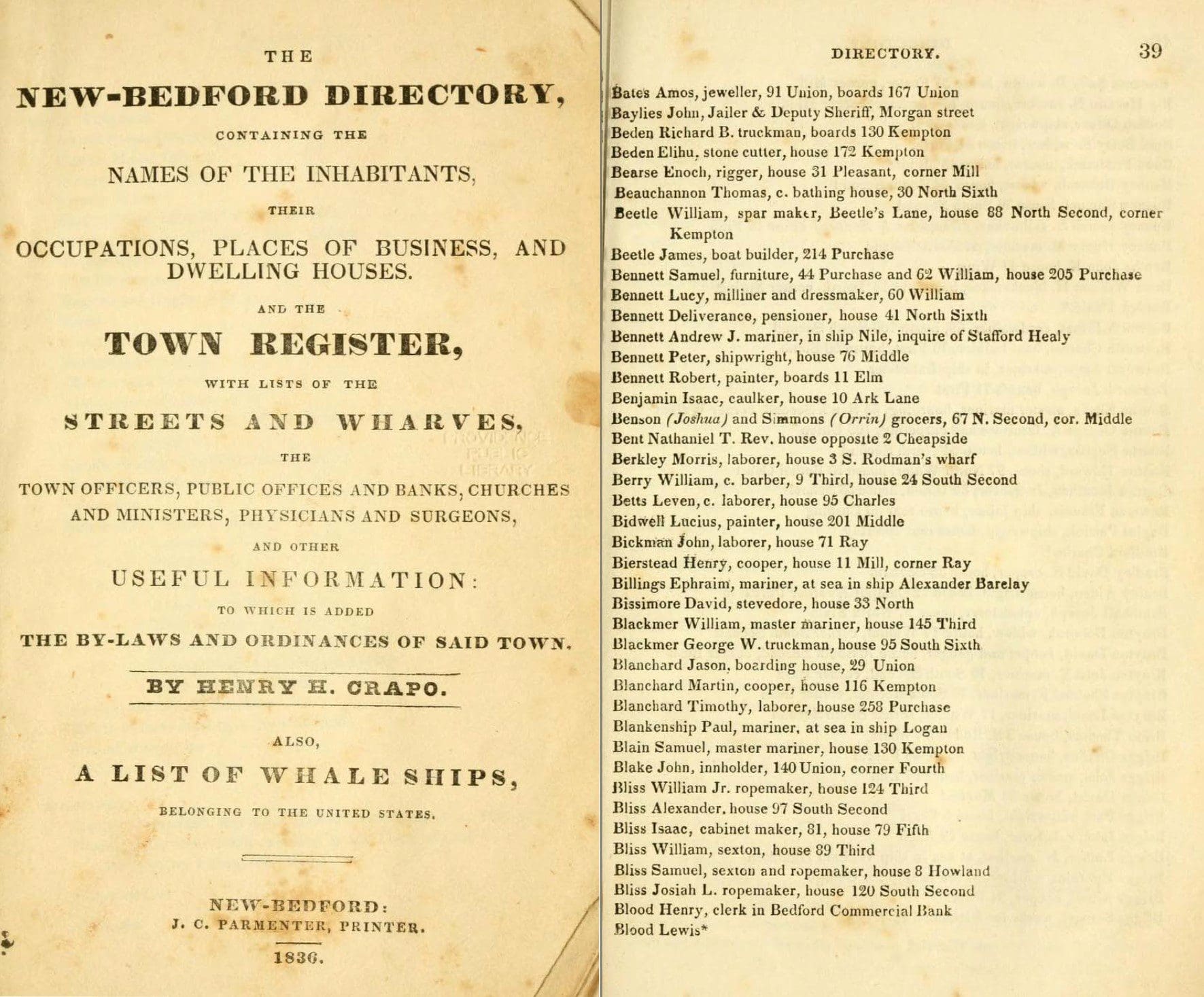
Henry Bierstadt listed in the 1836 New Bedford City Directory
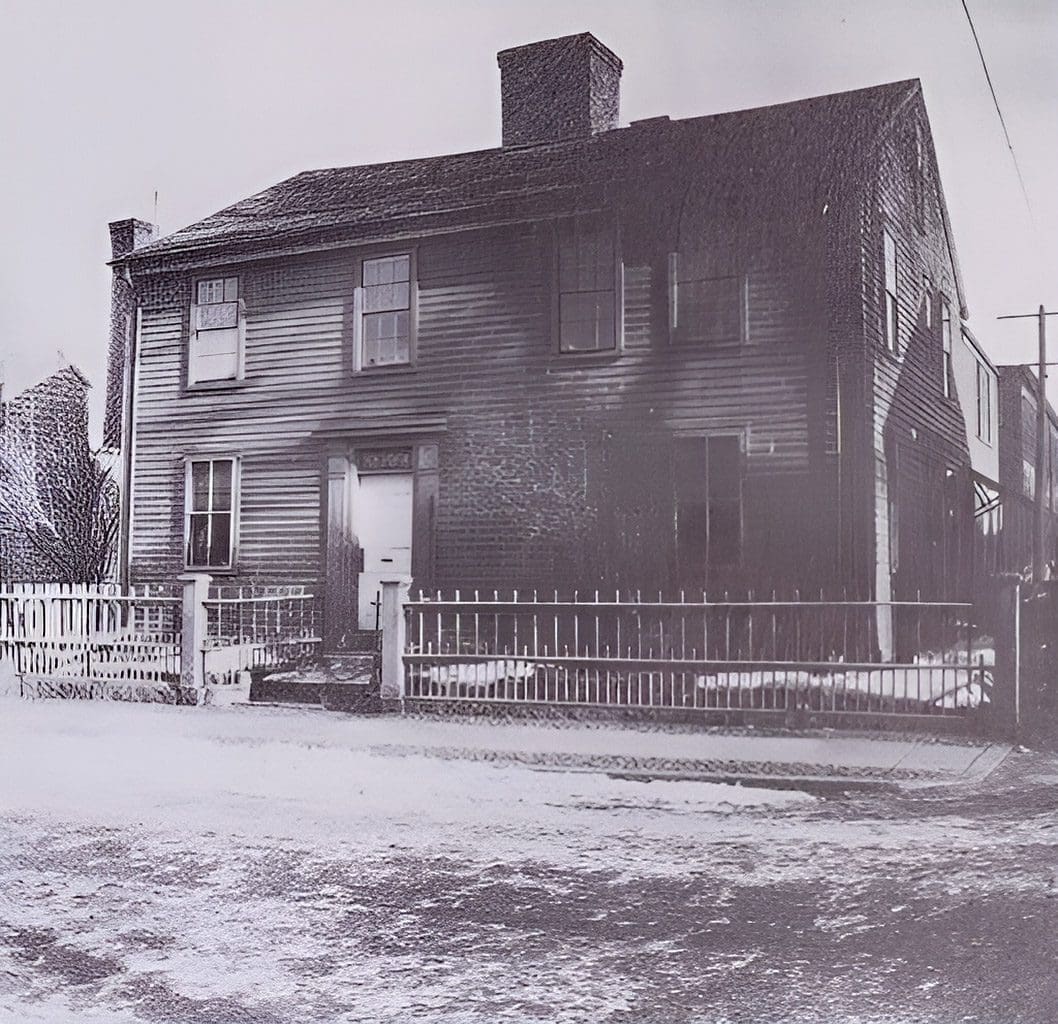
Albert Bierstadt's childhood home, 11 Mill Road, New Bedford
1841
- The Bierstadts are listed in the New Bedford City Directory, 1841
- Charles Bierstadt, wood turner, works 115 Purchase, boards 11 Mill
- Edward Bierstadt, apprentice to John M. Taber
- Henry Bierstadt, cooper, house 11 Mill.

Charles, Edward, and Henry Bierstadt are listed in The New Bedford City Directory, 1941
1842
- November 12, 1842: Charles Bierstadt was granted citizenship through naturalization by the Supreme Judicial Court of New Bedford.
- At just twelve years old, Albert Bierstadt’s adventurous spirit shone through in a school essay titled “The Rocky Mountains,” detailing a bear hunt rather than the landscapes he later became famous for. This is detailed in a Scribner’s Monthly article from 1872.
1847
- November 9, 1847: Edward Bierstadt was granted citizenship through naturalization by the Supreme Judicial Court of New Bedford.
1848
- Albert Bierstadt honed his craft by working at Shaw’s Frame Factory, a manufacturer of mirrors and picture frames on Purchase Street in New Bedford, although the specific duration of his tenure remains unrecorded.
1850
- On May 13, 1850, in New Bedford, Albert Bierstadt announced his first venture into teaching, offering lessons in monochromatic painting—a drawing technique—for a fee of $3 for 24 hours. (New Bedford Daily Evening Standard, May 13, 1850)
- On June 6, 1850, Albert Bierstadt advanced his promotional efforts by issuing a broadside to highlight his “improved system of monochromatic painting.”
- On August 27, 1850, Albert Bierstadt expanded his reach by advertising his “improved system of monochromatic painting” in Newport, Rhode Island, tapping into a new market. (Newport Daily News, August 27, 1850).

Improved System of Mono-Chromatic Painting Advertisement, Newport Daily News, August 27, 1850
- From September 11 to 28, 1850, Albert Bierstadt displayed 13 monochromatic paintings, primarily copies, and a drawing of Newport’s old Mill, at Boston’s Sixth Massachusetts Charitable Mechanic Association Exhibition in Faneuil and Quincy Halls.
1851
- The 1851 Boston City Directory lists “Bierstadt Albert, monochromatic painting, 265 Washington”.
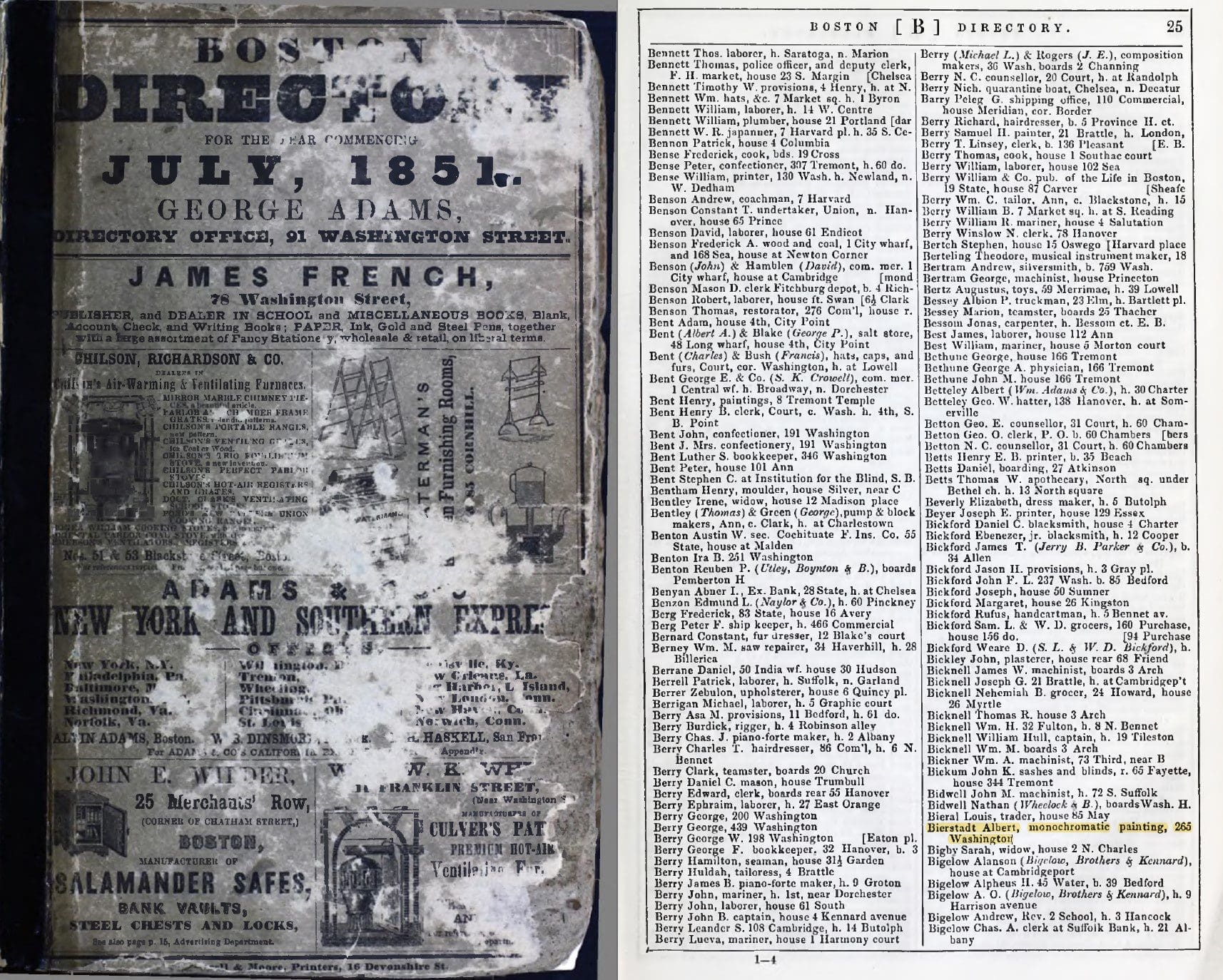
Albert Bierstadt listed in the 1851 Boston City Directory
- It is believed that 1851 is the year that Bierstadt began painting in oil.
- January 8, 1851: In Boston, Bierstadt began to offer instruction in “a new style of drawing,” capable of being easily replicated multiple times. This technique involved drawing on glass and transferring the image to paper, a method especially useful for creating copies of floral designs, embroidery patterns, and other designs. (Boston Transcript, January 8, 1851)
- On June 7, 1851, Bierstadt returned to Newport, offering lessons in “chromatic painting,” including techniques for colored crayon portraits and landscapes, either from life or copies. Additionally, he promoted a novel method of sketching from nature that students could learn in just one session. (Advertised in Newport Daily News on July 7, 1851, with the notice dated June 7)
- On August 14, 1851, William Hathaway Jr., pays $25 for Biertadt’s Ruins of Carthage, “picture and frame”.
1852
- On March 31, 1852, Boston’s Tremont Temple suffered a devastating fire that destroyed or damaged many artists’ studios, including those of Fitz Henry Lane, Benjamin Champney, Mr. Kimberly, John C. King, B. F. Mason, Wellman Morrison, John Pope, and John W. A. Scott. The Temple also housed the extensive art collection of Thomas Thompson, an American businessman and art collector. Much of Thompson’s art collection was lost to the flames, and he began assembling a new collection soon after, possibly acquiring several of Bierstadt’s early pieces.
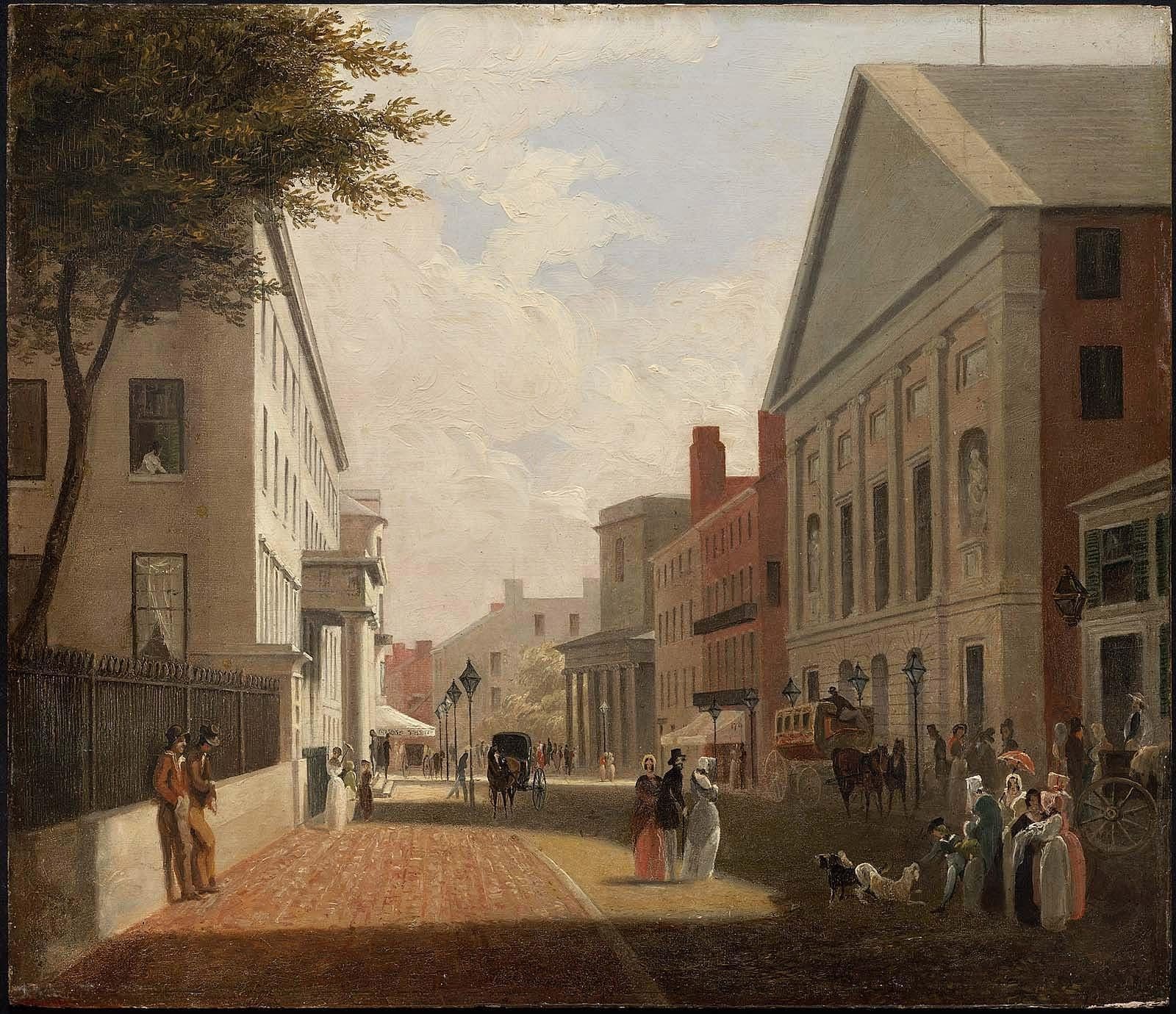
Tremont Street in Boston, ca. 1843
- On August 11, 1852, Albert Bierstadt visited the Summit House atop Mount Washington in the White Mountains of New Hampshire.
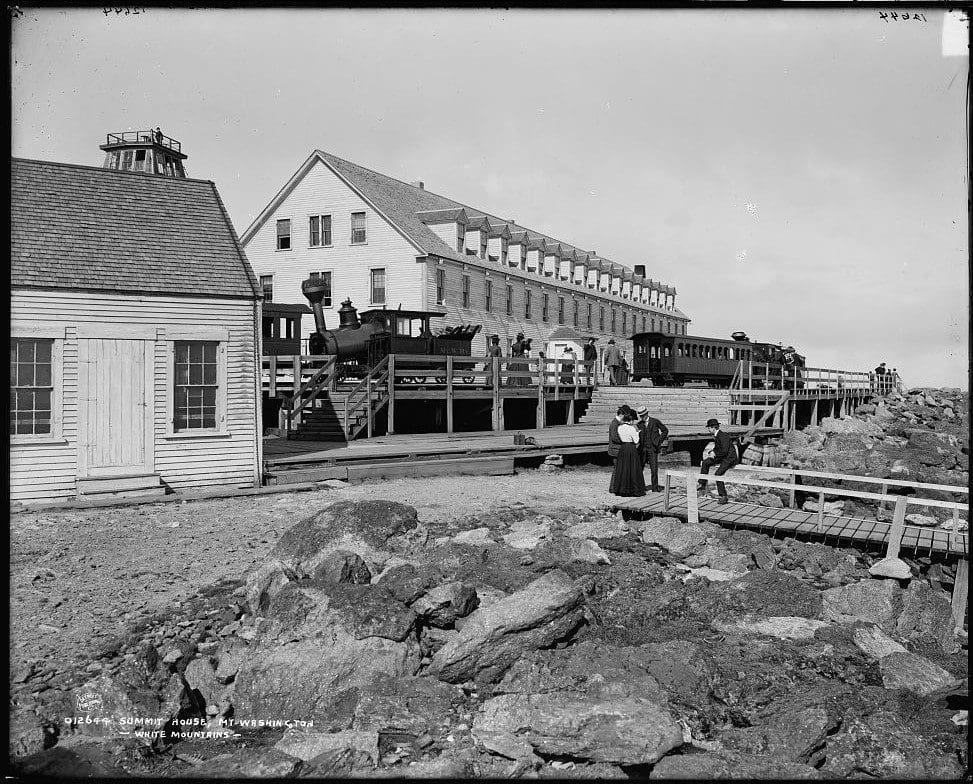
Summit House, Mount Washington in the White Mountains
1853
- From January 24 to May 1, 1853, in Boston, at the First Semi-Annual Exhibition of Paintings in the Gallery of the Massachusetts Academy of Fine Arts, Bierstadt exhibits “The Old Mill”.
- September 15, 1853: Albert Bierstadt obtained United States citizenship through naturalization at the U.S. District Court in Boston.
- September 24, 1853: Albert Bierstadt was issued Passport No. 2617 by the State of Massachusetts.
- November 1852: Albert Bierstadt sets sail for Europe, making a brief stop in London before continuing to Düsseldorf.

The Old Academy in Düsseldorf, oil on canvas painting by Andreas Achenbach, 1831
- December 16, 1853: Upon Bierstadt’s arrival in Düsseldorf, he learns that Johann Peter Hasenclever, the artist he had hoped to study with, had recently passed away.
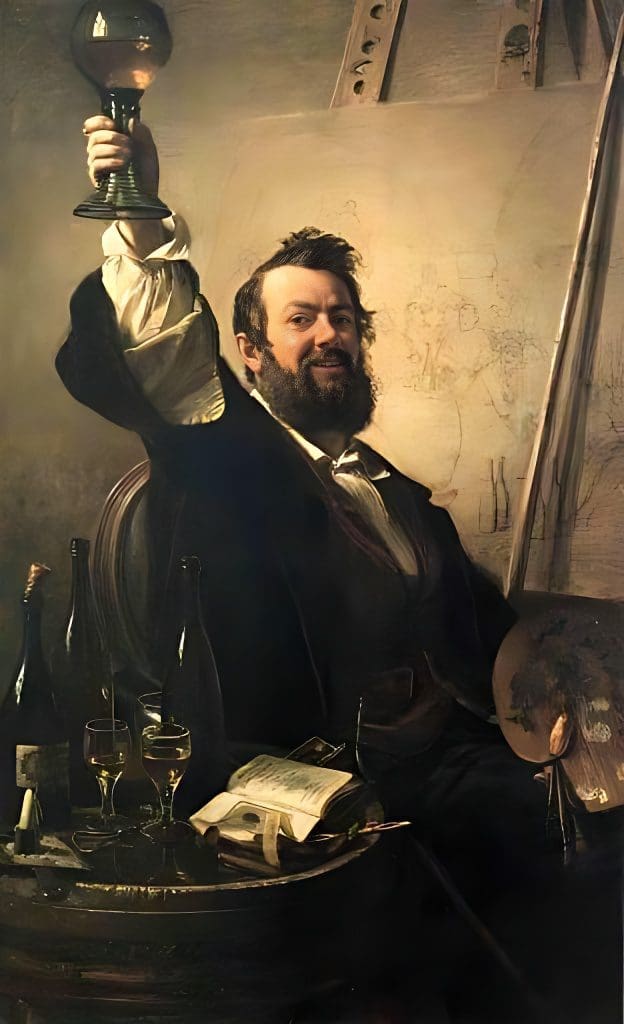
Johann Peter Hasenclever Self-Portrait, ca. 1851
- In Düsseldorf, Worthington Whittredge, another American artist, extends an offer to Bierstadt to share his studio space. According to Henry T. Tuckerman, Bierstadt then had the opportunity to receive instruction or support from notable artists such as Carl Friedrich Lessing, Andreas Achenbach, Emanuel Leutze, and Worthington Whittredge himself.
1854
- January 3, 1854: After experiencing travel restrictions outside Germany with his Massachusetts passport, Albert Bierstadt seeks a U.S. passport from the American Legation in Berlin.
- March 29, 1854: After extensive correspondence with Washington and his brother Edward, Albert Bierstadt secures U.S. passport No. 4585.
- April, 1854: Albert Bierstadt departs Düsseldorf for a sketching journey across the Westphalian countryside, not returning until the late fall.
- Fall, 1854: Upon his return to Düsseldorf and Whittredge’s studio, Bierstadt immediately starts dispatching his artworks to patrons in New Bedford.
1855
- March 23, 1855: Albert Bierstadt informs Mrs. Hathaway, a New Bedford patron, of dispatching the Westphalian landscape she commissioned, hinting at the upcoming delivery of “some large pictures” in the near future.
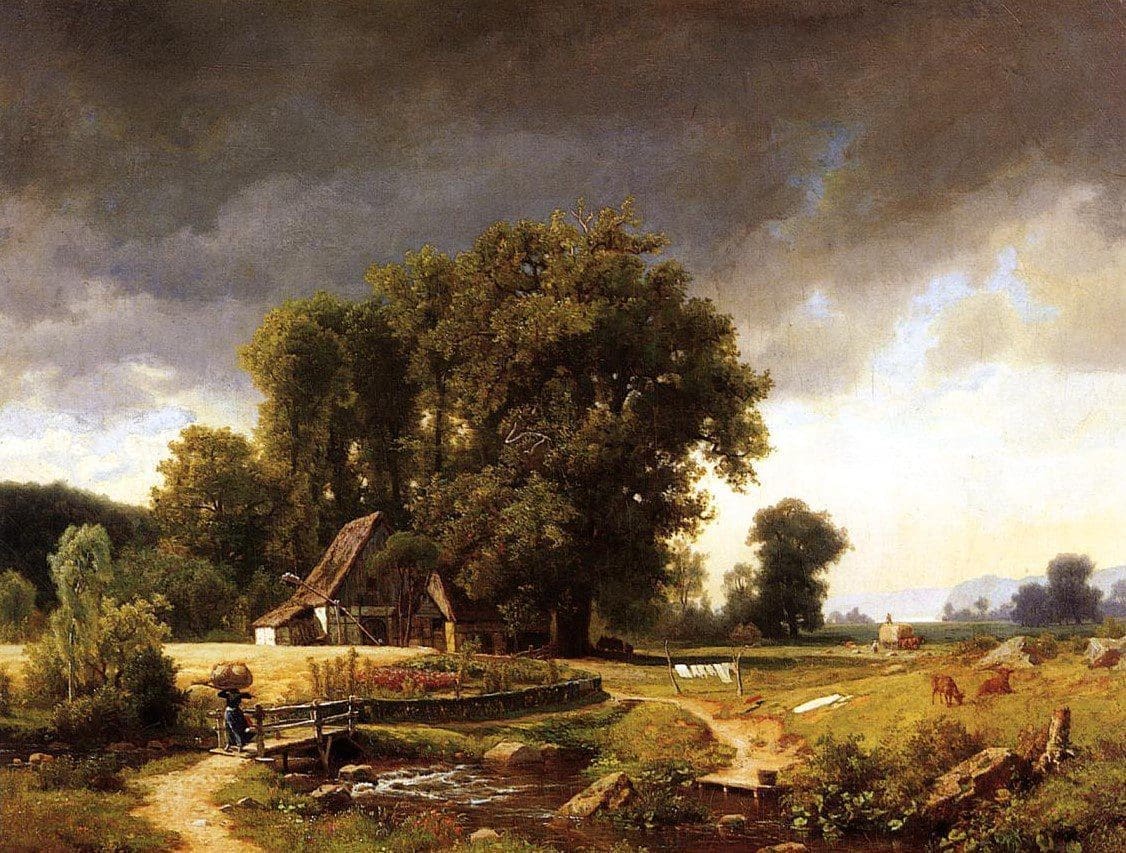
Westphalian Landscape by Albert Bierstadt, 1855, oil on canvas.
- May 30, 1855: A collection of Albert Bierstadt’s paintings, completed during his time in Europe, goes on display in New Bedford at the Commercial Insurance Company office. (New Bedford Evening Standard, May 30, 1855)
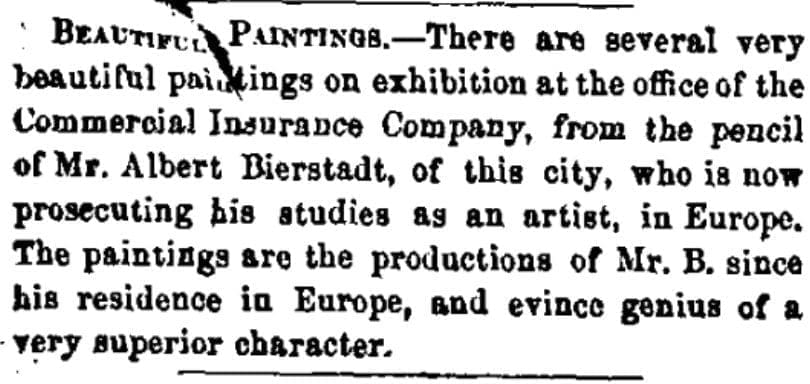
Bierstadt Exhibition at Commercial Insurance Company, New Bedford Evening Star, May 30, 1855
- Summer 1855: Albert Bierstadt embarks on a sketching tour across the German countryside, joined by Henry Lewis, an American artist and fellow student in Düsseldorf.

St. Louis, painted by Henry Lewis in 1846.
- July 30, 1855: An exhibition featuring likely six of Albert Bierstadt’s paintings is held at John Hopkins’s music store in New Bedford. Among them, four are named: “A Mill near Altena in Westphalia,” “A View of Cologne on the Drachenfels from Altenberg,” “Farm Scene in Westphalia,” and “View of the Weser near Minden.”
- Fall 1855-56: In reaction to allegations published in a New Bedford newspaper questioning the authenticity of paintings sent back by Bierstadt, Emanuel Leutze assures Bierstadt’s mother in a letter that the artworks were indeed created by Bierstadt in his Düsseldorf studio, mentioning Worthington Whittredge as his mentor. The letter is endorsed with supporting signatures from Andreas Achenbach, John Beaufain Irving, and William Stanley Haseltine.
1856
- By mid-June, 1856: Worthington Whittredge, Albert Bierstadt, Henry Lewis, William Henry Furness, Enoch Wood Perry, William Stanley Haseltine, John Beaufain Irving, among others, journey along the Nahe River, a tributary of the Rhine, to conduct sketching sessions near the village of Kirn. Sanford Robinson Gifford, initially planning to accompany them, opts for a trip to Switzerland instead.
- July 3, 1856: Supporters from New Bedford suggest a subscription-based acquisition of three Bierstadt paintings, currently displayed at John Hopkins’s store, for the new public library. The aim is to provide financial support to Bierstadt, who is reported to be in need of funds.
- Late July, 1856: Worthington Whittredge, William Stanley Haseltine, Albert Bierstadt, and possibly others, travel down the Nahe River to Bingen, then proceed along the Rhine towards Switzerland.
- July 27, 1856: While strolling near Lake Lucerne, Sanford Robinson Gifford encounters Worthington Whittredge, William Stanley Haseltine, and Albert Bierstadt, who plan to spend several weeks on the lake. Details about their time spent “on the lake” remain sparse. William Stanley Haseltine recalls that he and his peers stopped by Brunnen, located on Lake Lucerne’s eastern shore. There, they encountered Alexandre Calame, a Swiss artist celebrated for his Alpine landscapes, alongside his students. Following Bierstadt’s return from Europe, the titles of his showcased paintings hint at visits to locations around Lake Lucerne, including Küssnacht, Schwyz, Seelisberg, and the Rigi. From Lake Lucerne’s edges, they journeyed to Meiringen, traversing the Brünig Pass.
- September 1856: In Boston, four of Albert Bierstadt’s works were featured in the Eighth Exhibition of the Massachusetts Charitable Mechanic Association.
- September 3, 1856: Staying at a pension in Meiringen, known for hosting artists exclusively, Bierstadt and his companions spent enough time in the valley to ascend Reichenbach Falls and continue to the Rosenlaui Glacier and the base of the Faulhorn. The titles of accurately dated paintings reveal that, while stationed at the Bernese Alps’ foothills, Bierstadt and his group sketched notable landmarks such as the Wetterhorn, the Jungfrau, Lauterbrunnen, and Staubbach Falls.
- From September to October 1856: Albert Bierstadt, William Stanley Haseltine, Worthington Whittredge, and possibly others depart Switzerland for northern Italy, traveling through the Saint Gotthard Pass.
- October 1856: After crossing the Alps, the American artists explore several northern Italian lakes, with Worthington Whittredge highlighting Lago Maggiore and the enchanting Isola Bella. Subsequently, they head to Genoa to embark on a steamer bound for Leghorn. From Leghorn, their journey continues to Florence, and then, possibly in separate ways, to Rome.
1857
- Paints Martha Simon
- In August, Bierstadt leaves Italy and returns to New Bedford and tours the coastal areas.
1857-1858
- Resumes teaching and painting in New Bedford, exhibits, and takes trips to White Mountains, Newport and other areas.
1858
- April – Holds first “official” exhibition at the National Academy of Design in New York City, NY.
- July 1 – Organizes New Bedford’s first art exhibition
- December – First historical painting, Gosnold at Cuttyhunk, 1602.
1859
- April: Leaves with F. S. Frost for trip through West with Colonel Frederick W. Lander’s western expedition.
- July 10: In Wyoming, writes long letter to “The Crayon” detailing his artistic explorations and impressions of the Rocky Mountains.
- September 3: In Wolf River, Kansas, writes letter to The New Bedford Daily Mercury.
- December: Moves to Tenth Street Studio in New York City.
1860
- Explores the White Mountain region with his brothers and fellow photographers, Charles and Edward.
1861
- Visits Union troops on the Potomac alongside artist Emanuel Leutze.
1862
- Paints Sunlight and Shadow
1863
- March: Paints The Rocky Mountains, Lander’s Peak
- April: Ventures west again, to visit Nebraska, Colorado, Utah, California and Oregon, along the Columbia River with author Fitz Hugh Ludlow.
- August: Enters Yosemite Valley for the first time.
1864
- Paints Valley of the Yosemite, first known Yosemite painting.
- April: “The Rocky Mountains” debuts at the New York City Sanitary Fair, gaining widespread acclaim and rivals Frederick Church for the first time.
- May: Paints Mount Hood
1865
- Constructs his residence, Malkasten, in Irvington, New York, on the Hudson River.
1866
- January: Paints Storm in the Rocky Mountains
- November 21: Marries Rosalie Osborne Ludlow, the former wife of Fitz Hugh Ludlow in Waterville, New York.
1867
- April: Paints The Domes of the Yosemite.
- June 22: Sails with wife for two-year stay in Europe, to visit England, France, Germany, Austria, Switzerland, Italy and Spain. Receives an audience with Queen Victoria and is awarded the Legion of Honor by Napoleon III.
1868
- July 9 – Host in London’s Langham Hotel in honor of Longfellow.
1870
- Painted The Emerald Pool.
- Makes a trip to Europe for cultural and artistic engagement.
1871
- July: Leaves with wife for two year stay in California, where he meets and collaborates with photographer Eadweard Muybridge.
- September – December: Arranges entertainment for Grand Duke Alexsis of Russia.
1873
- January: Painted Donner Lake from the Summit
- May: Painted Autumn in the Sierras
- October 11: Leaves California with wife for return to East.
1875
- March – First national painting, The Discovery of the Hudson, finished.
1876
- Prominent guest with wife at Government Ball in Ottawa, Canada.
- Exhibits at Philadelphia Centennial.
1877
- October: Rocky Mountains, Longs Peak, commissioned by the earl of Dunraven, finished.
- Travels to the Bahamas, prompted by his wife’s declining health.
1878
- February: Stays at White House with President Hayes.
- July 20: Leaves with wife for a year in Europe.
1880
- June: Goes to California
- November: Goes to Washington, Vancouver, California
1881
- July – October: Journeys to Yellowstone Park.
1882
- November 10 – Malkastan, Bierstadt’s home in Irvington, New York, is destroyed by fire.
1883
- May: Supports duty-free works of art
- June: Visits Europe, promoting sale of newly patented shotgun to foreign governments.
1884
- May 28: Leaves Europe with wife
1886
- Visits Wisconsin and Lake Superior region
- Receives Order of Medjid from Sultan of Turkey
1887
- Vists Europe with wife
1888
- Paints The Last of the Buffalo
1889
- The Last of the Buffalo rejected for Paris Exposition.
- August – September: Visits Canadian Rockies and Alaska
1891
- Visits Spain, Italy, Portugal, and West Indies, making studies for The Landing of Columbus for World’s Columbian Exposition
1892
- May: Paints The Landing of Columbus
1893
- March 1: Rosalie Bierstadt passes away in Nassau
- May: Promotes establishment of a National Academy of Art.
1893-1896
- Patents for improvements on railway cars.
1894
- March 7: Weds Mary Hicks Stewart, his second wife.
1895
- Files for bankruptcy amid financial struggles.
1896
- May 12, 1896: Albert Bierstadt secures five patents for the design of an expandable railway car, numbered 559,962 to 559,966, as recorded by the U.S. Patent Office.
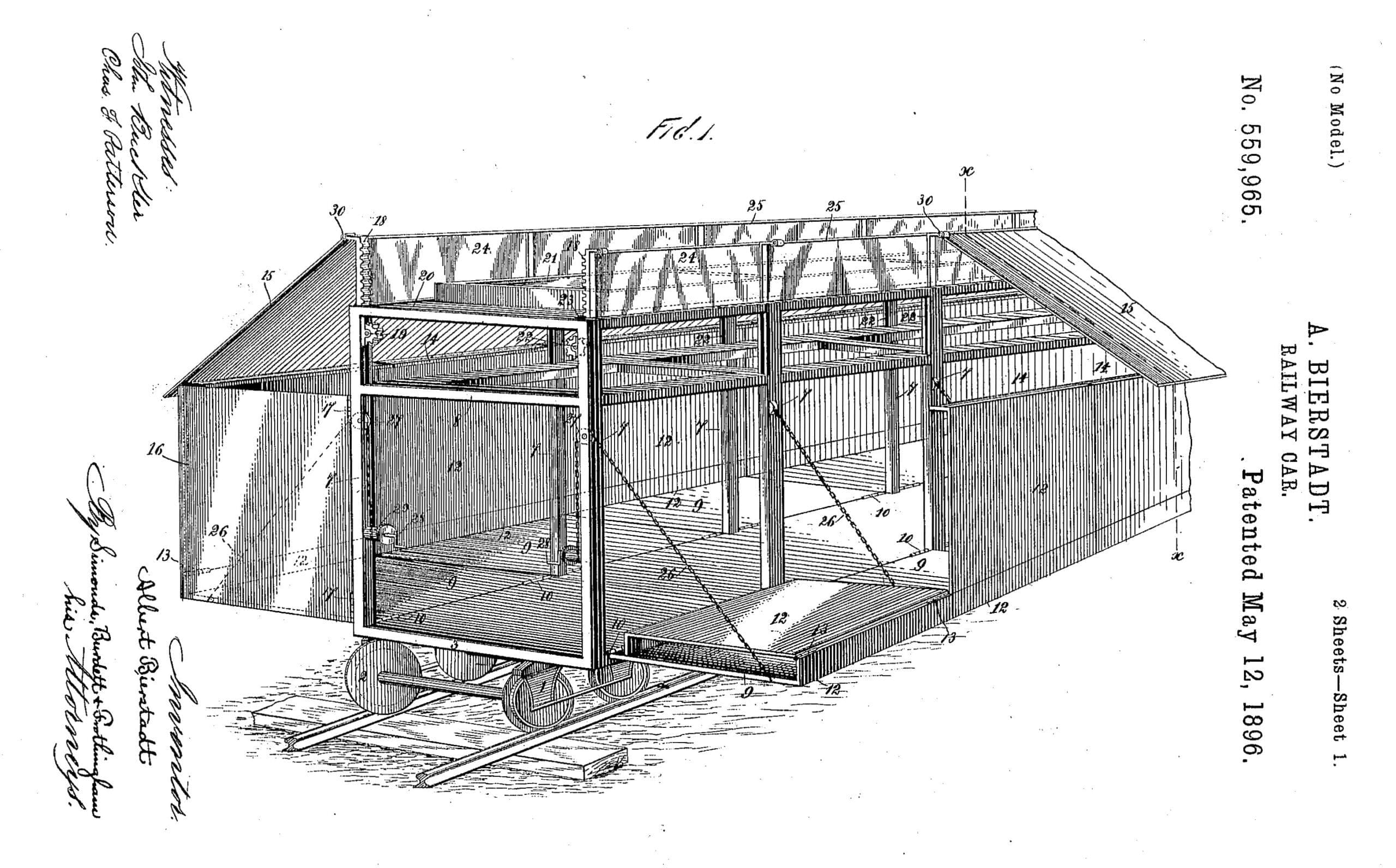
Albert Bierstadt Railcar Patent #US559965
- Albert Bierstadt sets sail for Europe aboard the RMS Majestic, a vessel of the White Star Line, with an initial stop planned in London followed by Paris.
- June 21, 1896: Albert Bierstadt is in Budapest, Hungary.
- June 26, 1896: Albert Bierstadt is in Lucerne, Switzerland.
- August 18, 1896: Albert Bierstadt secures an additional patent for the expanding railway car, numbered 566,127, as recorded by the U.S. Patent Office.
1897
- July 19, 1897: Albert Bierstadt is in Interlaken, Switzerland.
- August 24, 1897: Albert Bierstadt is in Lucerne, Switzerland.
1898
- January 1898: Albert Bierstadt is in New York.
- January 26, 1898: John Adams Porter, Secretary to President William McKinley, responds to Albert Bierstadt, confirming the receipt of his letter that recommended Colonel Chaille-Long for a role related to the Paris Exposition in 1900.
- July 20, 1898: Bierstadt is in Maine.
- August 18, 1898: Bierstadt is in New Jersey.
1899
- From February to March 1899: Between February and March 1899, Albert Bierstadt reaches out to President McKinley and Secretary of State John Hay, advocating for the government’s acquisition of land on the island of Corfu.
1900
- January 6, 1900: Albert Bierstadt is in New York.
- May 6, 1900: Albert Bierstadt reportedly goes to Paris, France.
1901

Mount Vesuvius at Midnight by Albert Bierstadt (ca. 1868)
1902
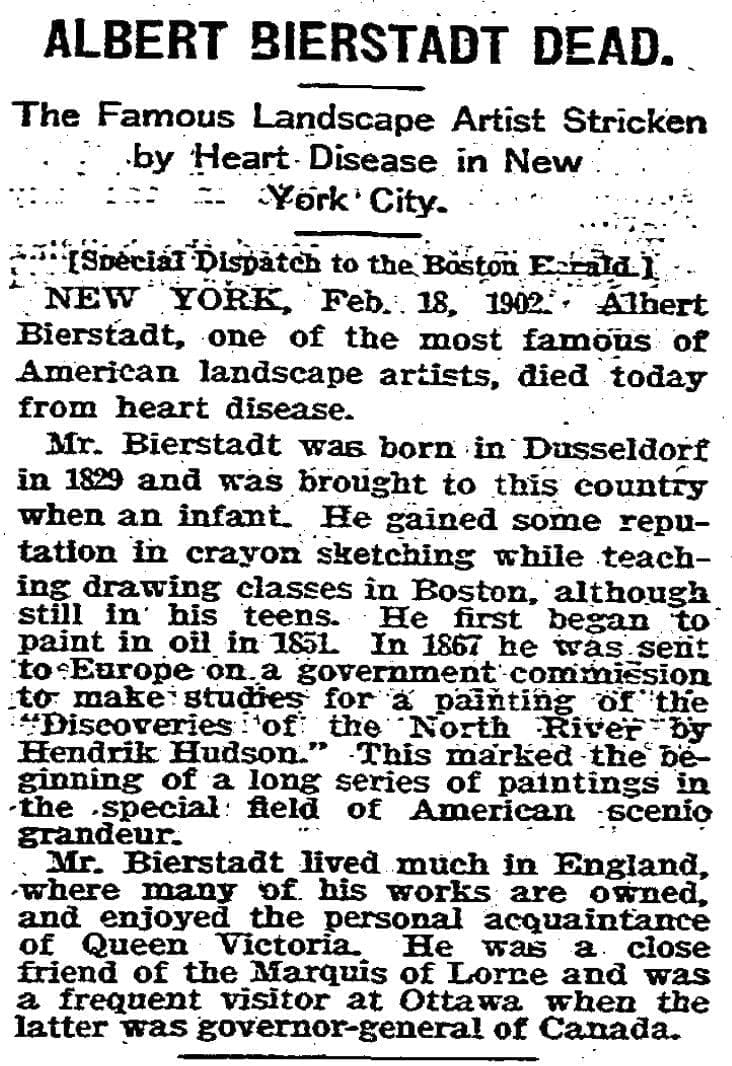
Boston Herald announcing Albert Bierstadt's death
